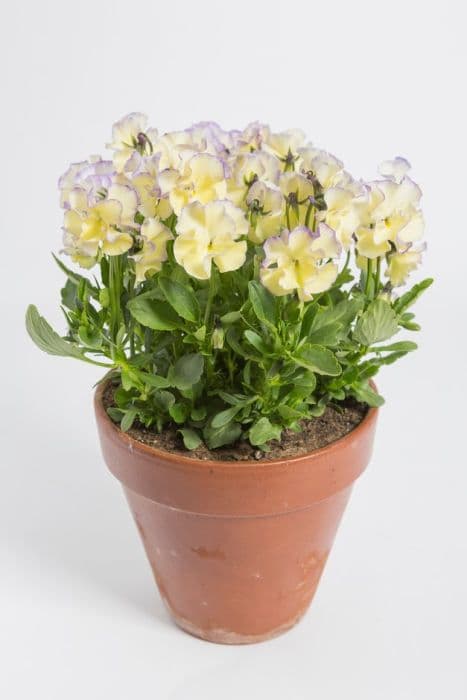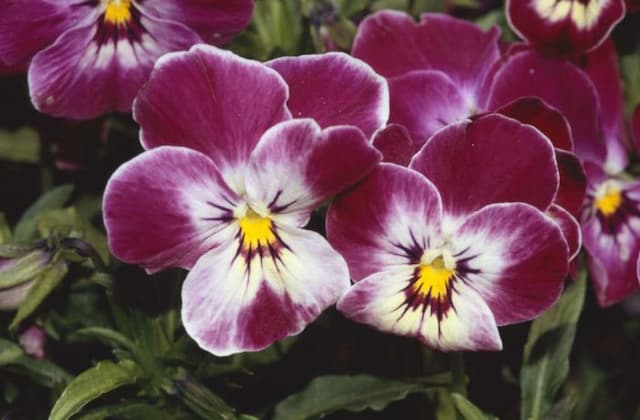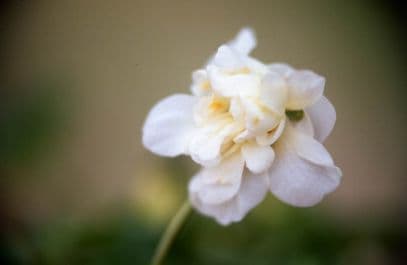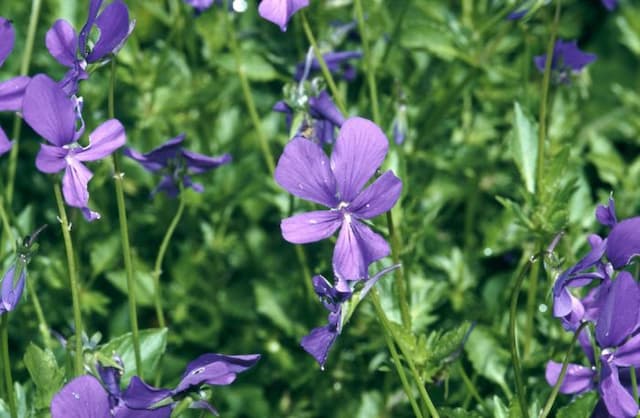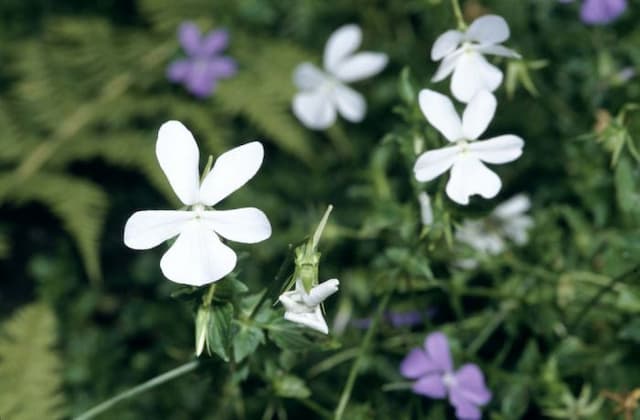Pansy Viola 'Velour Purple and White' (Velour Series)

ABOUT
The Viola 'Velour Purple and White' is part of the Velour Series which is known for its striking and vibrant flowers. This particular variety showcases a beautiful blend of colors with deep purple and pure white petals. The blooms have a classic pansy face pattern with a bold central blotch that contrasts with the surrounding color. The petals are velvety in texture, adding a luxurious feel to their appearance. The flower silhouette is round to slightly oval with overlapping petals creating a full look. The foliage of the plant is a lush green and consists of small, neat leaves that form a compact, mounding habit, which serves as an attractive backdrop to the showy flowers. The leaves are slightly ruffled or scalloped on the edges, adding to the ornamental value of the plant. This variety is popular for its eye-catching aesthetic and is often used in garden borders, containers, and as a bedding plant due to its floriferous nature.
About this plant
 Names
NamesFamily
Violaceae
Synonyms
Pansy, Viola
Common names
Viola 'Velour Purple and White', Viola cornuta 'Velour Purple and White'.
 Toxicity
ToxicityTo humans
Pansies, including Viola 'Velour Purple and White', are generally considered non-toxic to humans. They are often used as edible flowers in culinary arts; however, consuming them in large quantities or for individuals with specific allergies might cause mild digestive discomfort.
To pets
Pansies, like the Viola 'Velour Purple and White', are also generally considered non-toxic to pets such as dogs and cats. They are not known to cause severe poisoning. However, ingestion of plant material may result in mild gastrointestinal upset in some animals due to the novelty of the substance and individual sensitivities.
 Characteristics
CharacteristicsLife cycle
Perennials
Foliage type
Evergreen
Color of leaves
Green
Flower color
Mixed
Height
6 inches (15 cm)
Spread
10 inches (25 cm)
Plant type
Herb
Hardiness zones
5
Native area
Europe
Benefits
 General Benefits
General Benefits- Aesthetic Appeal: Adds a vibrant splash of purple and white colors to gardens and landscapes.
- Seasonal Interest: Offers early spring to late fall blooms in most climates, providing extended visual enjoyment.
- Pollinator Attraction: Attracts butterflies and other beneficial insects, which can help pollinate other plants in the garden.
- Compact Growth: Ideal for borders, containers, and small spaces due to its compact and mounding growth habit.
- Low Maintenance: Requires minimal care once established, which can save time and effort for gardeners.
- Cold Tolerance: Hardy in many climates, often able to withstand frost and colder temperatures, which extends its growing season.
- Versatility: Can be used in various garden designs, including rock gardens, window boxes, hanging baskets, and as ground cover.
 Medical Properties
Medical PropertiesThis plant is not used for medical purposes.
 Air-purifying Qualities
Air-purifying QualitiesThis plant is not specifically known for air purifying qualities.
 Other Uses
Other Uses- Crafting – The petals of pansies can be pressed and used in creating unique, floral-themed crafts such as bookmarks, greeting cards, or in decoupage projects.
- Photography – Due to their vibrant colors, pansies make for striking subjects in macro photography, which can accentuate the intricate patterns and textures of the blooms.
- Fabric Dyeing – Pansy flowers can be used as a natural dye for fabrics, imparting a delicate hue to silks and cottons.
- Edible Flower Garnish – Pansy petals can be used to add a splash of color and a mild, sweet flavor to salads or as an elegant garnish on desserts and drinks.
- Ice Cubes – Freeze pansy flowers inside ice cubes to create a decorative touch for punches and cocktails at special events or gatherings.
- Floral Arrangements – Though not unusual, pansies can be incorporated into small floral bouquets or table arrangements to bring color indoors.
- Plantable Confetti – Dried pansy petals can be used as a biodegradable alternative to traditional confetti at weddings or celebrations.
- Handmade Paper – Incorporate pansy petals into homemade paper to create textured, decorative sheets for stationary or gift wrapping.
- Scrapbooking – Pansies, either in petal form or as a whole flower, can be added to scrapbooks for a three-dimensional, colorful touch to memory pages.
- Floral Bath Salts – Pansy petals can be mixed with Epsom salts and essential oils to create aromatic bath salts for a relaxing and attractive soak.
Interesting Facts
 Feng Shui
Feng ShuiThe Pansy is not used in Feng Shui practice.
 Zodiac Sign Compitability
Zodiac Sign CompitabilityThe Pansy is not used in astrology practice.
 Plant Symbolism
Plant Symbolism- Innocence: The delicate nature of the viola often symbolizes innocence and purity, resonating with its gentle appearance.
- Humble Virtue: Traditionally, violas are seen as a representation of modesty and simple virtues, perhaps due to their unassuming size and quiet beauty.
- Spiritual Wisdom: Some cultures associate violas with introspection and a deep inner wisdom that belies their external simplicity.
- Remembrance: In the language of flowers, or floriography, violas can signify remembrance, making them suitable for occasions that honor the past or our memories.
- Love: Specified in colors, purple violas, like the 'Velour Purple and White', often stand for thoughts of love, whether it be romantic or platonic.
- Mysticism and Enchantment: The intricate patterns and color contrasts of the 'Velour Purple and White' viola may symbolize the enchanting and sometimes mystical nature of love and life.
- Healing: Violas have been used in herbal medicine, and as such, can sometimes symbolize healing and medicinal properties.
 Water
WaterPansies prefer consistently moist soil, so it's important to water them thoroughly whenever the top inch of soil feels dry to the touch. Depending on weather conditions, this might mean watering once every few days, especially during dry spells. It is best to provide enough water to soak the soil deeply, promoting strong root growth—this could equate to approximately 1 gallon for an outdoor garden area of one square foot every week, but always adjust based on rainfall and temperature conditions. Avoid overhead watering to keep the foliage dry and prevent fungal diseases. Always check the soil moisture level before watering to avoid overwatering.
 Light
LightPansies thrive in full to partial sunlight, so the best spot for the Viola 'Velour Purple and White' would be where it can receive at least 6 hours of direct sunlight a day. They can tolerate some shade, especially in the hotter parts of the day, but too much shade can lead to fewer flowers and leggy growth. An ideal location would receive morning sunlight and partial afternoon shade, ensuring that the plants enjoy light without being exposed to the heat of the day for too long.
 Temperature
TemperaturePansies prefer cooler temperatures and can survive in temperatures ranging between 40°F and 60°F, which are ideal for the Viola 'Velour Purple and White'. They can tolerate a frost and survive short periods in temperatures as low as 20°F but perform best when nighttime temperatures are above freezing. Extended exposure to heat above 80°F can stress the plant, often resulting in reduced flowering.
 Pruning
PruningPruning pansies involves deadheading spent flowers to encourage more blooms and to keep the Viola 'Velour Purple and White' looking its best. Regularly check for and remove any faded blooms throughout the flowering season. Additionally, trim back leggy stems to promote bushier growth. The best time to prune is when flowers begin to fade and before they set seed to ensure continuous blooming.
 Cleaning
CleaningAs needed
 Soil
SoilPansies, including Viola 'Velour Purple and White', thrive in loamy, well-drained soil with a pH between 5.4 and 5.8. A mix of garden soil, peat moss, and perlite or vermiculite is ideal for maintaining good moisture while providing adequate drainage and aeration.
 Repotting
RepottingPansies generally do not require frequent repotting as they are often grown as annuals. If grown as perennials, repotting can be done every 1-2 years to refresh the soil.
 Humidity & Misting
Humidity & MistingPansies prefer moderate humidity levels but can tolerate a wide range from slightly dry to average household humidity conditions without issue.
 Suitable locations
Suitable locationsIndoor
Ensure bright light, cool temps, and moist soil.
Outdoor
Plant in partial sun, rich soil, and water regularly.
Hardiness zone
6-10 USDA
 Life cycle
Life cycleThe viola 'Velour Purple and White' starts its life as a seed, which, when sown in a well-draining soil mix and kept moist, will germinate usually within 2-3 weeks. Following germination, the seedlings develop their first true leaves and gradually mature into vegetative plants with characteristic lush foliage. Once established and provided with adequate sunlight and nutrients, the plant enters the flowering stage, where it produces its signature bicolored purple and white blossoms, attracting pollinators and potentially setting seed if the flowers are fertilized. After the flowering phase, if the conditions allow it, the viola may enter a period of dormancy, particularly in areas with cold winters, only to regrow from its root system with the arrival of warmer weather. If the plant is an annual variety in the Velour Series, it will complete its lifecycle within one year; however, if it's a perennial, it will enter into a seasonal cycle of dormancy and regrowth over several years. Seeds formed from the fertilized flowers can be collected and sown to begin the life cycle anew or the plant may self-seed under suitable conditions.
 Propogation
PropogationPropogation time
Springtime
Viola 'Velour Purple and White', commonly known as pansy, can be propagated through the popular method of seed sowing. Seeds can be started indoors 8 to 12 weeks before the last frost date in your area. Sow pansy seeds thinly in trays filled with a well-draining seed starting mix, covering them lightly with a fine layer of the substrate as pansy seeds require darkness to germinate. Keep the soil moist but not waterlogged and maintain a temperature of around 65 to 70 degrees Fahrenheit (18 to 21 degrees Celsius). Seedlings typically emerge in 14 to 21 days. Once seedlings have developed their first true leaves, they can be transplanted into individual pots and eventually moved outdoors after the danger of frost has passed.
